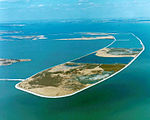Detroit River Light
1884 establishments in MichiganBuildings and structures in Monroe County, MichiganHouses completed in 1884Lighthouses completed in 1884Lighthouses on the National Register of Historic Places in Michigan ... and 3 more
Michigan State Historic SitesNational Register of Historic Places in Monroe County, MichiganTransportation in Monroe County, Michigan

The Detroit River Light, also known as Bar Point Shoal Light, was first established as a lightship in 1875. The current sparkplug lighthouse was built in 1885. It sits in Lake Erie, south of the mouth of the Detroit River, 1.75 nautical miles (3.24 km; 2.01 mi) from land and about 20 nautical miles (23 mi; 37 km) from the Ambassador Bridge in the Detroit River. It is about 0.4 nautical miles (0.74 km; 0.46 mi) from the border with Canada, and just under 24 nautical miles (44 km; 28 mi) from Put-in-Bay, Ohio. Its original 4th order Fresnel lens is on loan to the Michigan Maritime Museum.
Excerpt from the Wikipedia article Detroit River Light (License: CC BY-SA 3.0, Authors, Images).Detroit River Light
Geographical coordinates (GPS) Address External links Nearby Places Show on map
Geographical coordinates (GPS)
| Latitude | Longitude |
|---|---|
| N 42.00075 ° | E -83.140680555556 ° |
Address
Detroit River Light
Michigan, United States
Open on Google Maps











